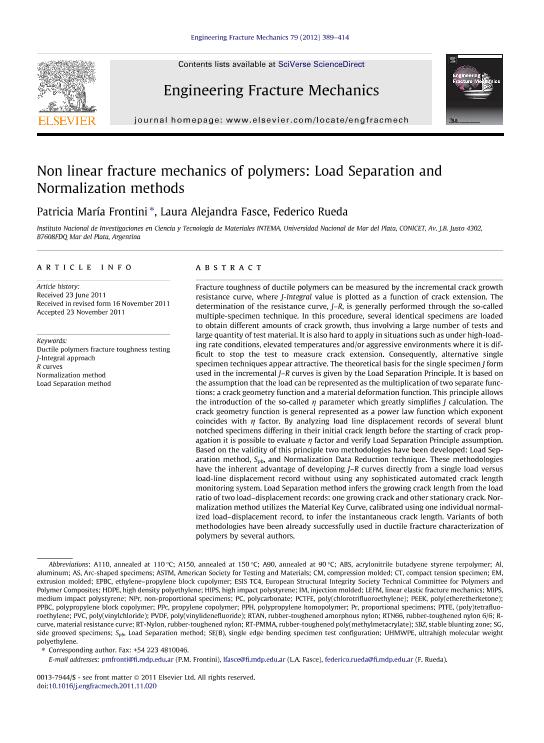Artículo
Non linear fracture mechanics of polymers: Load Separation and Normalization methods
Fecha de publicación:
01/2012
Editorial:
Pergamon-Elsevier Science Ltd
Revista:
Engineering Fracture Mechanics
ISSN:
0013-7944
Idioma:
Inglés
Tipo de recurso:
Artículo publicado
Clasificación temática:
Resumen
Fracture toughness of ductile polymers can be measured by the incremental crack growth resistance curve, where J-Integral value is plotted as a function of crack extension. The determination of the resistance curve, J-R, is generally performed through the so-called multiple-specimen technique. In this procedure, several identical specimens are loaded to obtain different amounts of crack growth, thus involving a large number of tests and large quantity of test material. It is also hard to apply in situations such as under high-loading rate conditions, elevated temperatures and/or aggressive environments where it is difficult to stop the test to measure crack extension. Consequently, alternative single specimen techniques appear attractive. The theoretical basis for the single specimen J form used in the incremental J-R curves is given by the Load Separation Principle. It is based on the assumption that the load can be represented as the multiplication of two separate functions: a crack geometry function and a material deformation function. This principle allows the introduction of the so-called η parameter which greatly simplifies J calculation. The crack geometry function is general represented as a power law function which exponent coincides with η factor. By analyzing load line displacement records of several blunt notched specimens differing in their initial crack length before the starting of crack propagation it is possible to evaluate η factor and verify Load Separation Principle assumption. Based on the validity of this principle two methodologies have been developed: Load Separation method, S pb, and Normalization Data Reduction technique. These methodologies have the inherent advantage of developing J-R curves directly from a single load versus load-line displacement record without using any sophisticated automated crack length monitoring system. Load Separation method infers the growing crack length from the load ratio of two load-displacement records: one growing crack and other stationary crack. Normalization method utilizes the Material Key Curve, calibrated using one individual normalized load-displacement record, to infer the instantaneous crack length. Variants of both methodologies have been already successfully used in ductile fracture characterization of polymers by several authors.Innovatively here, the Load Separation Principle and the deformation function are expressed in terms of total displacement without distinguishing between elastic and plastic displacement components. Hence, calculations are simply made using the J-Integral formula based on total energy. The performance of the proposed methods is evaluated and compared with the standard multiple-specimen technique for a broad spectrum of ductile polymers. Several features of the approaches are discussed like: suitability of functional forms, influence of blunting assumption, calibration points and general limitations to their application. The results demonstrate the ease and the accurate of the Normalization method based on total displacement for ductile polymer J-R curve determination. Conversely, the great potentiality of Load Separation method relies on the special fracture cases in which the actual final crack length cannot be easily determined. © 2011 Elsevier Ltd.
Archivos asociados
Licencia
Identificadores
Colecciones
Articulos(INTEMA)
Articulos de INST.DE INV.EN CIENCIA Y TECNOL.MATERIALES (I)
Articulos de INST.DE INV.EN CIENCIA Y TECNOL.MATERIALES (I)
Citación
Frontini, Patricia Maria; Fasce, Laura Alejandra; Rueda, Federico; Non linear fracture mechanics of polymers: Load Separation and Normalization methods; Pergamon-Elsevier Science Ltd; Engineering Fracture Mechanics; 79; 1-2012; 389-414
Compartir
Altmétricas




